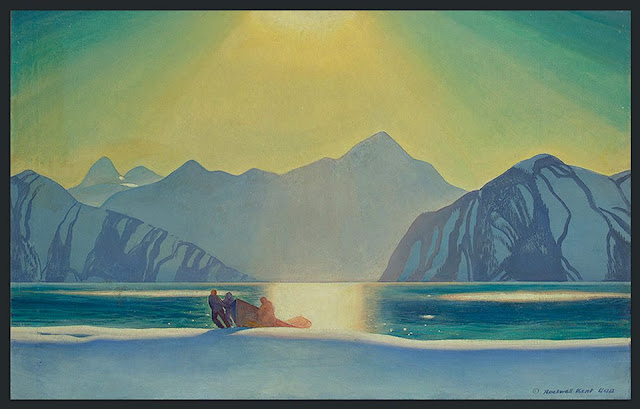August 4 and 5, 2018
ROCKWELL KENT WILDERNESS CENTENNIAL JOURNAL
100 YEARS LATER
by Doug Capra © 2018
100 YEARS LATER
by Doug Capra © 2018
“Above every other thought now is the sad realization that our days on this beloved Island are nearing an end. What is it that endears it so to a man nearly forty and a little boy of nine? We have such widely different outlooks upon life. It may be that Alaska stands midway between us, and that I, turning backward from the crowded world that I have known and learned to fear, meet Rockwell in his forward march from nothing – to this…It seems that we have both together by chance turned out of the beaten, crowded way and come to stand face to face with that infinite and unfathomable thing which is the wilderness; and here we have found OURSELVES – for the wilderness is nothing else.”
Rockwell Kent in “Wilderness” for Wednesday, February 19, 1919.
The above quote contains the title of my book-in-progress. While the artist and his son are heading toward Vancouver, British Columbia on the Canadian Pacific Railway 100 years ago this week – I’ll provide some backstory to his life. The following is from my book which is footnoted, but I have not included the sources here.
From “That Infinite and Unfathomable Thing: Rockwell Kent’s Alaska Wilderness” © 2018
“In his later years-- an avowed socialist associated with communist-front organizations and accused of being a member of the party – it is ironic that Kent’s family origins couldn’t be more American. By the 1930's, though, Kent was more political and his views did get inserted into some of his art.
(I must point out that Kent's Alaska paintings and sketches are not political at all. His outspoken radicalism and occasional confrontational behavior (he liked to push people's buttons), resulted in some seeing his politics in his works. While in Newfoundland in 1915, officials had refused to allow Kent to ship out a painting, "Portrait of a Child," because they saw hidden in the lines of the child's face and body, forts and coastal defense units. Years later, looking at that painting of his daughter, "our little Clara," he marveled at her "lying in flower-like nakedness peacefully asleep on a sky-blue coverlet, a little white-walled village with its spired church nestled among the distant hills -- stark hills, to be sure, and somber hued, but like our earth -- and one star shining through the rifted clouds, I wonder how I could in those days have retained the hope, the love of life that is inherent in it.")
Thomas Kent arrived in Gloucester, Massachusetts before 1643. Zenas Kent was a veteran of the Revolutionary War. Our Rockwell Kent’s grandfather, George Lewis Kent, was one of Zenas’ nine children. Matilda Rockwell, George’s wife, came from a family that arrived here on the Mary and John in 1630. George earned a fortune in New York with his hotels and wholesale merchant business. His son, our artist’s father, was the first Rockwell Kent. He not only studied mining engineering in the U.S. but also at Freiburg, Germany – a connection with that culture that influenced his son’s life.
Rockwell Kent was a patriotic American, not hesitant to severely criticize his country when he found it necessary. His 1940 memoir "This is My Own," takes its title from this Walter Scott poem:
Breathes there a man with soul so dead
Who never to himself hath said,
This is my own, my native land!
Whose heart hath ne’re within him burned
As home his footsteps he hath turned
From wandering on a foreign strand?
Who never to himself hath said,
This is my own, my native land!
Whose heart hath ne’re within him burned
As home his footsteps he hath turned
From wandering on a foreign strand?
Kent’s mother, Sara Ann Holgate, was sent at age eleven to live with her mother’s sister and brother-in-law, Josie and James Banker. Sara’s uncle was one of New York’s first millionaires and connected to the Vanderbilts. Sara was raised on their estate at Irvington, not far from Tarrytown. Her “overprotective and confining” upbringing was a not happy one. She grew up “lonely and quietly rebellious.” As she got older and entertained suitors her jealous uncle would angrily question her judgment, referring to the callers as fools. Before she met Kent’s father, Banker had hounded and discouraged at least one young man. When she did encounter the first Rockwell in the late summer of 1880, Sara knew any relationship had to be kept secret. His and her friends with the help of Banker servants loyal to Sara, aided the couple’s clandestine courtship. Banker refused with contempt Kent’s request to marry his niece, so the two eloped.
PHOTOS, courtesy of the Rockwell Kent Gallery
1. Sunglare, Alaska 1919. Oil on canvas laid down on plywood, 72x112
2. Young Rockwell Kent.
2. Young Rockwell Kent.






Comments
Post a Comment